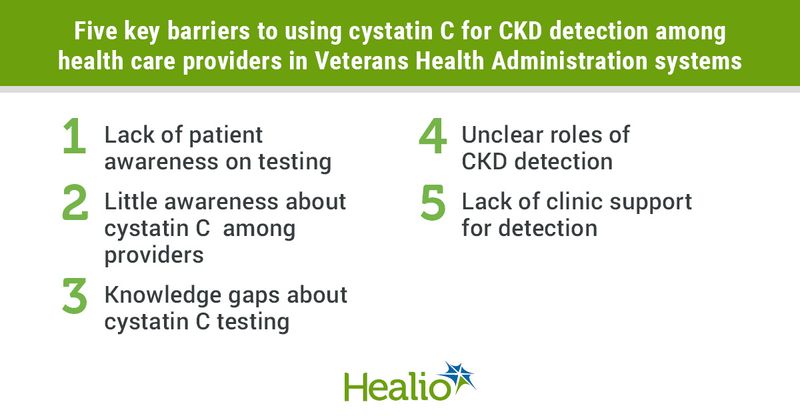Targeted intervention may help combat barriers that limit cystatin C use in CKD detection
Key takeaways:
- Researchers identified five key barriers to using cystatin C in CKD detection.
- Improved clinical workflows and electronic health record aids may support the use of cystatin C.
Targeted educational and training programs may help address barriers that could limit cystatin C use in clinical practice for enhanced chronic kidney disease detection, according to published data.
“Cystatin C is less affected by external non-kidney factors than creatinine and is more strongly associated with adverse health outcomes. It provides more accurate eGFR estimates when the coefficient for race is removed,” Julio A. Lamprea-Montealegre, MD, MPH, PhD, of the department of medicine at the University of California, San Francisco, wrote with colleagues. However, “ ... The adoption of cystatin C in routine CKD detection by health systems is uncertain. Traditional obstacles to CKD testing, such as the limited time and resources faced by primary care providers, could be exacerbated by specific barriers related to cystatin C.”

Researchers conducted a qualitative study of health care providers, nephrologists and clinical pharmacists representing stakeholders in kidney disease detection and management. Participants were part of Veterans Health Administration (VHA) systems in San Francisco, San Diego and Houston. Using the Organizational Theory of Implementation Effectiveness, investigators developed a semi-structured guide to conduct in-depth interviews between 2021 and 2022. The final sample totaled eight physicians, three nurse practitioners, two nurses and one clinical pharmacist across three sites. Most physicians worked in primary care, and the three nurse practitioners also worked in gerontology.
Researchers identified the following five key barriers to using cystatin C for CKD detection: lack of patient awareness on testing; little awareness about cystatin C among providers; knowledge gaps about cystatin C testing; unclear roles of CKD detection; and lack of clinic support for detection.
While the results may not be generalizable to non-VHA systems, Lamprea-Montealegre and colleagues wrote that educational and training programs, improved clinical workflows and electronic health record aids may support cystatin C.
“Enhancing early detection and management of CKD is a public health priority,” they wrote. “Future research should further explore the implementation and effectiveness of these strategies across different settings, aiding the continuous efforts to improve CKD outcomes.”
